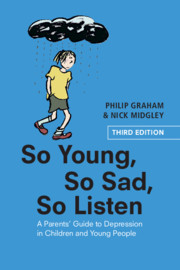Book contents
- So Young, So Sad, So Listen
- So Young, So Sad, So Listen
- Copyright page
- Contents
- Foreword to Second Edition
- Acknowledgements
- Introduction
- Chapter 1 How Can You Know if Your Child Is Depressed?
- Chapter 2 Understanding Depression in Children and Young People
- Chapter 3 What Parents Can Do to Help Build a Child’s Resilience to Depression
- Chapter 4 Helping Children Cope with Common Stresses: What Parents Can Do
- Chapter 5 When a Child Is Depressed: What Parents Can Do
- Chapter 6 Getting Professional Help: A Guide to Services for Children and Young People with Depression
- Chapter 7 Last Words – from a Parent
- Chapter 8 Message to Governments
- Resources and Further Reading
- Index
Chapter 4 - Helping Children Cope with Common Stresses: What Parents Can Do
Published online by Cambridge University Press: 22 June 2020
- So Young, So Sad, So Listen
- So Young, So Sad, So Listen
- Copyright page
- Contents
- Foreword to Second Edition
- Acknowledgements
- Introduction
- Chapter 1 How Can You Know if Your Child Is Depressed?
- Chapter 2 Understanding Depression in Children and Young People
- Chapter 3 What Parents Can Do to Help Build a Child’s Resilience to Depression
- Chapter 4 Helping Children Cope with Common Stresses: What Parents Can Do
- Chapter 5 When a Child Is Depressed: What Parents Can Do
- Chapter 6 Getting Professional Help: A Guide to Services for Children and Young People with Depression
- Chapter 7 Last Words – from a Parent
- Chapter 8 Message to Governments
- Resources and Further Reading
- Index
Summary
In the previous chapter we discussed some of the things all parents can do to help build children’s resilience and help reduce their chances of developing depression. But there are also some specific stresses that are known to be associated with depression in children and teenagers. When children suffer from depression, it is always important to think of the events that might have triggered the problem. In some children, the stress that has brought on the problem will be obvious; in others it will be far from clear. In this chapter, we focus on six of the most common stresses experienced by children and young people (experiences of loss; parental conflict and separation; academic pressure; bullying and online abuse; gender identity issues; and physical ill health), and discuss what parents can do to help children who face such difficulties.
- Type
- Chapter
- Information
- So Young, So Sad, So ListenA Parents' Guide to Depression in Children and Young People, pp. 40 - 53Publisher: Cambridge University PressPrint publication year: 2020



